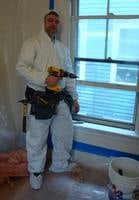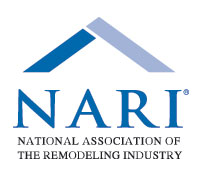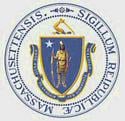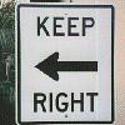Deleading vs. Renovation, Repair and Painting Work: What's the Difference?
Note: The following information is from the MA Labor and Workforce Development Web site.
 While deleading activities conducted in residences and child-occupied facilities often involve work methods similar to those typically used in renovation, repair or painting (RRP) activities, such as replacing windows, painting and installing vinyl siding, the two types of activities are distinct from each other in terms of purpose and effect.
While deleading activities conducted in residences and child-occupied facilities often involve work methods similar to those typically used in renovation, repair or painting (RRP) activities, such as replacing windows, painting and installing vinyl siding, the two types of activities are distinct from each other in terms of purpose and effect.
Deleading work is work conducted to achieve compliance with the Massachusetts Lead Law through the abatement of lead paint hazards. Carried through to completion, deleading work leads to the issuance of a document called a Letter of Compliance, which indicates that the property has met deleading requirements administered by the Childhood Lead Poisoning Program of the Massachusetts Department of Public Health (CLPPP) under the Massachusetts Lead Law and 105 CMR 460.000. In some instances, deleading work takes place after the owner has received an order to bring the property into compliance with the Massachusetts Lead Law. In other instances, the owner voluntarily decides to delead the property and seek a Letter of Compliance.
Renovation work (RRP work) is work conducted for a fee that disturbs more than threshold amounts of painted surfaces in pre-1978 residences (target housing) and child-occupied facilities (kindergartens, daycares, etc.), where the purpose of the work is other than the abatement of lead paint hazards or the achievement of a Letter of Compliance. Renovation work is often carried out to repair, upgrade or beautify the property.
 Once you have made the initial determination regarding whether your project is a renovation project or a deleading project, the next question is how to choose a contractor who is licensed and qualified to perform the work. Click on the following link to view a helpful guide on choosing a deleading contractor, “Deleader Contractor Information Bulletin.” Click on the following link to view a helpful guide on choosing a “lead safe” renovation contractor, “Lead Safe Renovation Contractor Information Bulletin.”
Once you have made the initial determination regarding whether your project is a renovation project or a deleading project, the next question is how to choose a contractor who is licensed and qualified to perform the work. Click on the following link to view a helpful guide on choosing a deleading contractor, “Deleader Contractor Information Bulletin.” Click on the following link to view a helpful guide on choosing a “lead safe” renovation contractor, “Lead Safe Renovation Contractor Information Bulletin.”

 Looking for accurate information about the EPA RRP rule?
Looking for accurate information about the EPA RRP rule?  Yesterday
Yesterday  In my opinion, the ability to work with and interact with the same people who not only enforce the rule in MA, but also have the ability to help shape the MA RRP rule, has been a major plus for those Massachusetts contractors affected by the rule. At the budget hearing I shared this opinion and stressed that I hoped DOS would get adequate budgeting to keep such communication opportunities available in the future. Here are a few of the items I suggested at the hearing:
In my opinion, the ability to work with and interact with the same people who not only enforce the rule in MA, but also have the ability to help shape the MA RRP rule, has been a major plus for those Massachusetts contractors affected by the rule. At the budget hearing I shared this opinion and stressed that I hoped DOS would get adequate budgeting to keep such communication opportunities available in the future. Here are a few of the items I suggested at the hearing:
 The Commonwealth of MA Executive Office of Labor and Workforce Development will be holding public hearings where interested parties can attend to provide suggestions to Joanne F. Goldstein, the Secretary of Labor and Workforce Development, regarding how the money appropriated to the Department of Labor (DOL) and the Division of Occupational Safety (DOS) should be spent in Fiscal Year 2012.
The Commonwealth of MA Executive Office of Labor and Workforce Development will be holding public hearings where interested parties can attend to provide suggestions to Joanne F. Goldstein, the Secretary of Labor and Workforce Development, regarding how the money appropriated to the Department of Labor (DOL) and the Division of Occupational Safety (DOS) should be spent in Fiscal Year 2012. Proper and effective administration and enforcement of the RRP rule will take money. Because the amount of money the DOS and DOL will get in 2012 is already decided, contractors must voice their opinion as to how they think the money should be spent. It is my opinion that the money could actually be invested in the health and safety of Massachusetts citizens to protect them from the dangers associated with contractors who ignore lead-safe work practices. And, if properly and adequately enforced, the RRP rule would not only help to eliminate the underground construction economy here in Massachusetts, it would also help bring in additional revenue for the state in fees to those who get licensed to do the work, in fines to those who operate illegally and in taxes collected if all construction businesses doing RRP work have to pay their equal share of payroll and income taxes.
Proper and effective administration and enforcement of the RRP rule will take money. Because the amount of money the DOS and DOL will get in 2012 is already decided, contractors must voice their opinion as to how they think the money should be spent. It is my opinion that the money could actually be invested in the health and safety of Massachusetts citizens to protect them from the dangers associated with contractors who ignore lead-safe work practices. And, if properly and adequately enforced, the RRP rule would not only help to eliminate the underground construction economy here in Massachusetts, it would also help bring in additional revenue for the state in fees to those who get licensed to do the work, in fines to those who operate illegally and in taxes collected if all construction businesses doing RRP work have to pay their equal share of payroll and income taxes.  Massachusetts, one of the states delegated by EPA to administer and enforce the RRP rule, released a new form and protocol to be used by Massachusetts licensed lead inspectors when doing testing for lead prior to a RRP project. Although under the Massachusetts and EPA RRP rules a certified renovator can use EPA approved test kits to do this testing, as an alternative some home owners and renovators may elect to have the testing done by a lead testing professional. The following article was written by
Massachusetts, one of the states delegated by EPA to administer and enforce the RRP rule, released a new form and protocol to be used by Massachusetts licensed lead inspectors when doing testing for lead prior to a RRP project. Although under the Massachusetts and EPA RRP rules a certified renovator can use EPA approved test kits to do this testing, as an alternative some home owners and renovators may elect to have the testing done by a lead testing professional. The following article was written by 

 RRP Assessment report or from a Lead Safe Renovator who has used an EPA approved lead based paint test kit to test surfaces for lead, to all tenants or potential buyers.
RRP Assessment report or from a Lead Safe Renovator who has used an EPA approved lead based paint test kit to test surfaces for lead, to all tenants or potential buyers. In addition to the OSHA rules contractors should already have been aware of related to worker safety, the EPA RRP rule has added yet additional OSHA concerns for renovators. One for example is working on a surface covered with plastic. OSHA considerations related to working on plastic are not part of the curriculum delivered during the required EPA certified renovator training. Due to the absence of this information, the EPA is essentially leaving it up to renovators to become aware of such considerations on their own. Once aware, renovators must seek out the information they need and adjust their work practices accordingly to avoid fines from OSHA should they get randomly inspected. Or worse, have a worker accident.
In addition to the OSHA rules contractors should already have been aware of related to worker safety, the EPA RRP rule has added yet additional OSHA concerns for renovators. One for example is working on a surface covered with plastic. OSHA considerations related to working on plastic are not part of the curriculum delivered during the required EPA certified renovator training. Due to the absence of this information, the EPA is essentially leaving it up to renovators to become aware of such considerations on their own. Once aware, renovators must seek out the information they need and adjust their work practices accordingly to avoid fines from OSHA should they get randomly inspected. Or worse, have a worker accident.  This begs a few questions. First, were the authors ignorant of such considerations? Asked another way, does the left hand know what the right hand is doing? Is this another example of a breakdown in communication between very significant departments of our government charged to look out for our best interests? A second question might be; did the authors of the EPA RRP rule leave this information out of the rule for a strategic purpose? Perhaps this is just one more way to force small independent businesses out of the construction industry in favor or labor unions.
This begs a few questions. First, were the authors ignorant of such considerations? Asked another way, does the left hand know what the right hand is doing? Is this another example of a breakdown in communication between very significant departments of our government charged to look out for our best interests? A second question might be; did the authors of the EPA RRP rule leave this information out of the rule for a strategic purpose? Perhaps this is just one more way to force small independent businesses out of the construction industry in favor or labor unions.  Of bigger concern should be the distribution of misinformation at the certified renovator training. For example, using the sample signage included in the EPA approved training manual (required to be posted outside contained work areas), might just get you in trouble with OSHA. First off the RRP rule requires the use of a “warning” sign, but the sample sign is a “caution” sign. OSHA considers a warning sign to be a stronger message than a caution sign, and has rules dictating when and how to choose one versus the other.
Of bigger concern should be the distribution of misinformation at the certified renovator training. For example, using the sample signage included in the EPA approved training manual (required to be posted outside contained work areas), might just get you in trouble with OSHA. First off the RRP rule requires the use of a “warning” sign, but the sample sign is a “caution” sign. OSHA considers a warning sign to be a stronger message than a caution sign, and has rules dictating when and how to choose one versus the other.  Variances in the rule requirements, from the EPA RRP rule and also from state to state, will make it difficult for renovators to understand the differences and keep up with amendments made by each entity. Renovators working in more than one state many have to become certified firms in each state they operate in and or also with the EPA. Are renovators better off if their states write a better thought out rule? Would renovators be better served if there was just one well written rule for everyone to follow? I predict that confusion may likely contribute to violations and fines for these renovators.
Variances in the rule requirements, from the EPA RRP rule and also from state to state, will make it difficult for renovators to understand the differences and keep up with amendments made by each entity. Renovators working in more than one state many have to become certified firms in each state they operate in and or also with the EPA. Are renovators better off if their states write a better thought out rule? Would renovators be better served if there was just one well written rule for everyone to follow? I predict that confusion may likely contribute to violations and fines for these renovators.  The MA DOS has also started conducting on-site inspections. Though most inspections are triggered by citizens reporting suspected violations, the DOS is also out in the field and is stopping by renovation projects as they come across them. In one of his recent blogs, RRP certification training provider and business coach, Mark Paskell of The Contractor Coaching Partnership, shares a
The MA DOS has also started conducting on-site inspections. Though most inspections are triggered by citizens reporting suspected violations, the DOS is also out in the field and is stopping by renovation projects as they come across them. In one of his recent blogs, RRP certification training provider and business coach, Mark Paskell of The Contractor Coaching Partnership, shares a 

 EPA recognizes that, when used by trained professionals, the
EPA recognizes that, when used by trained professionals, the 


